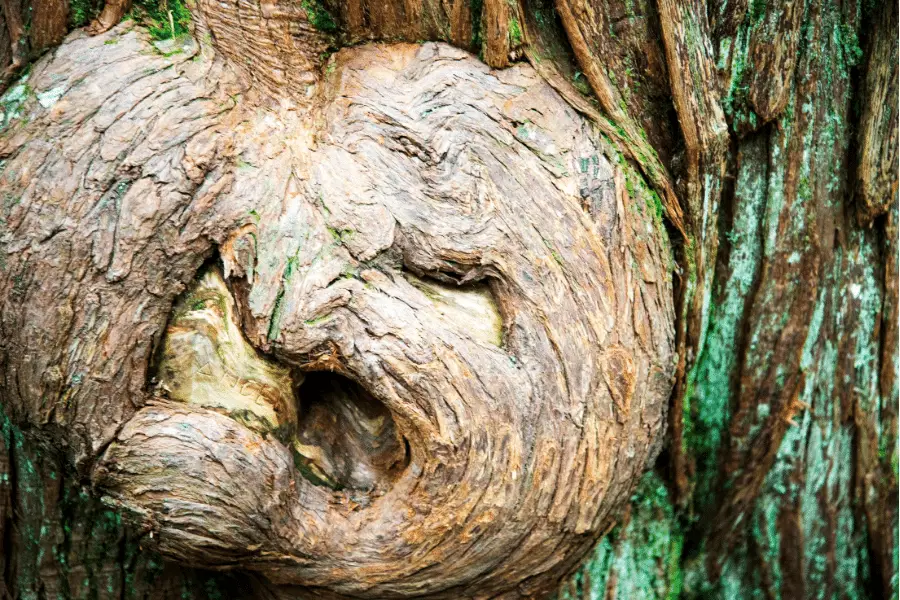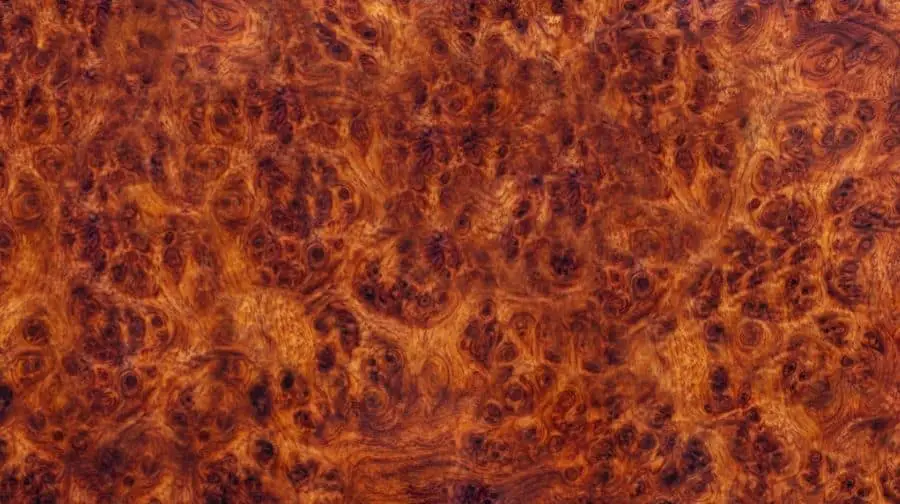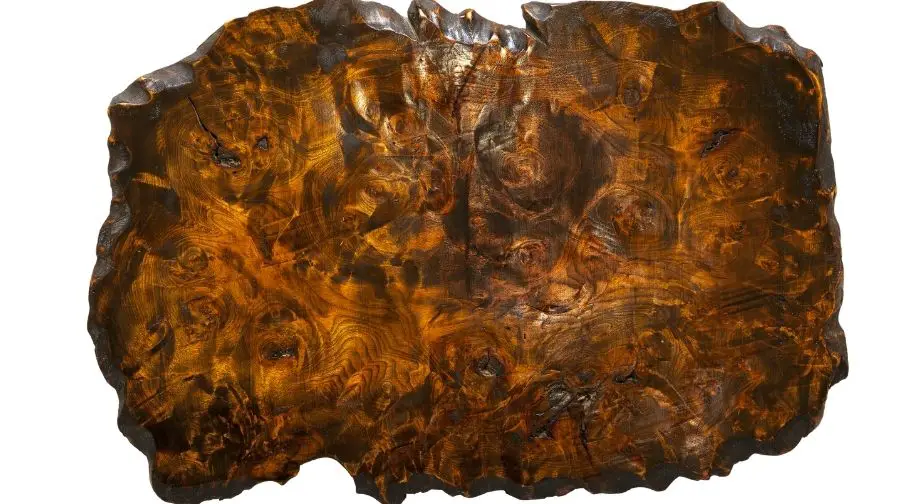
Burl wood is an irregular growth on a tree either on the surface or underground.
What is burl wood? Burl wood is a grain characteristic that takes place in many different types of wood. A burl is formed as a result of the tree undergoing some form of stress which could be caused by an injury, fungus, or virus on the tree.
Keep reading below to learn more about burl wood.
Table of Contents
What Is Burl Wood?
Burl wood is an irregular growth on a tree when its grain grows in a deformed manner. It is sometimes referred to as a bur or burr. The wood burl is usually found as a round outgrowth of a tree trunk or branch that is filled with small knots from dormant buds.
The burl in wood is a grain characteristic that takes place in many different types of wood. A burl is formed as a result of the tree undergoing some form of stress which could be caused by an injury, fungus, or virus on the tree. Insect infestation as well as some types of mold infestation serve as the primary causes of the growth of burl on the tree.
What Is Burl Wood Used For?
Burl wood is used for a variety of things, including furniture, bowls, and other turned objects. It’s also used for veneers and inlay work. Burl wood is highly prized because it’s so unusual-looking. The swirls and patterns you find in burl wood are created when the tree undergoes stress, which could be from an injury or a disease. Because of this, burl wood is often referred to as “stress wood.”
Burl wood is also used for musical instruments and gun stocks. It’s even used in some high-end vehicles, like Rolls-Royces, where a single burl can cost hundreds or even thousands of dollars.
What Causes A Burl To Form On A Tree?
Burls are actually quite common in trees, and there are a few different causes of why they form. One of the most common reasons is stress. This could be from things like severe weather conditions, damage to the tree, or even just being in a crowded area where the roots don’t have enough room to spread out. Burls can also be caused by a fungus or bacteria infection, which usually enters the tree through an injury.
While most burls are harmless, there are some cases where they can cause problems for the tree. If the burl is large and heavy, it can put stress on the tree and make it more susceptible to falling over. In some cases, the burl can also girdle the tree, which means it grows around the trunk and cuts off the flow of water and nutrients. If this happens, it can eventually kill the tree.
How Much Is Burl Wood Worth?
Burl wood is worth a lot of money. In some cases, it can be worth more than $100 per board foot. That means that a single burl could be worth hundreds or even thousands of dollars.
It is highly sought after by woodworkers and craftsmen because of its unique grain pattern. Burls are often used to make furniture, bowls, vases, and other wood products.
It is also popular among collectors. Some people collect burl wood for its beauty, while others collect it for its value.
It can be found in many different types of trees, but the most valuable burls come from redwood trees. Redwood burls are especially prized for their red color and beautiful grain patterns.
If you’re lucky enough to find a burl, you could be sitting on a small fortune. Burl wood is valuable because of its unique grain pattern and beautiful colors. If you think you may have found a burl, it’s best to have it appraised by a professional before selling it.
Where Does Burl Wood Grow?
Most types of burl grow underground, attached to the roots of a tree, almost secretly, and are usually not found out till the tree falls over or dies. The burls that grow beneath the ground often seem to look like groups of lumps connected by a series of roots. Tree burls are normally covered by the bark of the tree, even if they grow underground.
To the average person, burl wood is just wood. This is not true because burl wood has nothing in common with normal timber apart from them both being made of wood. Burl wood is preferred because of its beauty and it evokes emotion in whatever product it is used to make whereas timber is favored due to its ability to create solid structures.

How Do You Harvest Burls?
Burl wood is produced by harvesting the part of a tree that has a burl which is the knobby looking growth on the base and trunk on the tree. The burls are relatively easy to spot, and after they are obtained from the tree, they are then taken to a processing facility.
Any form of rough or splintering wood is first removed from the burls. Then the burls are pressure washed to get rid of all the debris and then the burls are cut using large mills and chainsaws. At this point, they will take the form of slabs, after which they are dried and secured. This process guarantees that they are ready for finish and they would not crack and warp when finished.
In some certain species of trees, such as the coast redwoods (Sequoia sempervirens) the burls can grow to sizes as large as 26’. The burl could even encircle the entire circumference of the tree, and if enough moisture is present, grow completely new redwood trees. Burl wood is quite difficult to work with hand tools or on a lathe, because its grain is mangled and interlocked which makes it chip and shatter randomly. This grain, which is sometimes referred to as “wild grain”, makes the burl wood extremely dense and resistant to splitting.
Where Can I Find Wood Burls?
There are several ways that you can find burl wood. An easy way is to go into the forest and look for trees growing in damp areas. You should generally look for trees, and you will find a couple that have burls on them. It is certainly interesting, though that regardless of the size of the burl growth, it does not harm the tree in any way or even shortens the tree’s lifespan.
Burl wood can be obtained from different species of wood including:
1. Amboyna: This is one of the world’s rarest and most expensive veneers. The color ranges from a deep yellow-orange to red and the burl has stellar beauty and is great for architectural work and cabinetry.
2. Eucalyptus: This is a popular veneer that is favored for the shimmering ripple effect of its grain. It is available in a wide range of colors and its burls are usually larger than most burls.
3. Redwood: The redwood produces a very rich and stunning veneer that is typically deep reddish-brown. The redwood tree produces some of the largest burled veneers in the world, mainly due to the large size of the tree itself.
4. Thuya: This is one of the richest and most beautiful burls in the world. Nowadays, the thuya is rarely cut for lumber, instead, the tree is dug up to produce burls. The color of the burl ranges from light tan to deep chocolate brown.
5. Birch-Korelian: This veneer is cut from the burls found on Birch trees that are found in forests in Russia and Finland. The veneer that is obtained from these trees is unusually beautiful and it is rotary cut because of the small diameter of the burl.
6. Maple: The maple tree produces a lovely veneer that ranges in color from whitish to a warm yellow and it typically has a beautiful straight grain and it is used a lot in furniture making.
7. Walnut: The walnut veneer comes in two different forms; the American black and the European veneers. The American walnut is rich and dark with a gorgeous swirling grain interspersed with clusters of burl while the European walnut is one of the most popular veneers in the world with its smooth and even texture.
8. Oak: The American Oak veneers are typically smaller in diameter than European oak and range in color from golden brown to grey. The oak veneer has a distinct grain pattern.

Can You Cut A Burl Without Killing Tree?
Burl wood is in fact, a sustainable and eco-friendly product if it is properly harvested. And even though the burl growth does make the tree look horrible, you may end up killing the tree if you try to just remove the burl from it. Instead, the burl should only be removed from a dead tree or a tree that has been planned to be removed. And before you purchase burl wood, be sure to ask for its origin from the buyer, as burl wood poachers cut down trees just for their burls or harvest the burls straight from a healthy tree killing it in the process.
How Much Is Burl Wood Worth?
Burls are used to produce a very distinctive and special wood that is favored for its beauty and rarity. The burls are highly valued and are sliced into veneers for furniture, picture frames, musical instruments, inlay in doors, automobile interior paneling, woodturning, and household objects.

